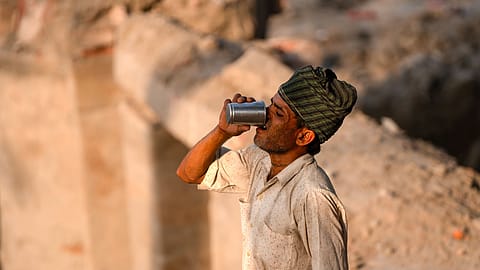Outdoor workers vs. 50°C: Why India's top human rights body wants to declare access to AC a basic human right
In India Heat Summit 2025, there is a growing consensus that declaring access to AC must be made a basic human right as extreme heat begins to endanger outdoor workers, livelihoods, and public health.

As record-breaking temperatures grip large parts of India, rising temperatures are not only a climate issue, but a human rights emergency now. With over 24,000 deaths attributed to extreme heat in India over the past three decades, the conversation at the India Heat Summit 2025 highlighted an urgent and growing consensus, access to sustainable and affordable cooling must be treated as a basic right, on par with water, health, and sanitation.
“Heat protection stands for the protection of the human right to life,” said Bharat Lal, secretary general of the National Human Rights Commission (NHRC), in a keynote address that set the tone for the summit. “It must be treated like access to water, sanitation, and healthcare. This is no longer a luxury. It is a vital necessity.”
Just last month, the NHRC issued letters to 11 state governments urging proactive measures to safeguard vulnerable groups such as outdoor workers, the elderly, and the homeless. “The dignity of our workforce, especially those in the unorganised sector, including agricultural and farm labourers, must be preserved if we are to build a truly resilient economy,” he said.
Nearly 46% of India’s population is part of the agricultural workforce, supporting close to 70% of the country’s economic activity. This deep interdependence between climate and livelihood, Lal stressed, makes heat resilience an economic imperative, not just a humanitarian one.
Yet, India’s current approach to managing heat stress faces significant hurdles. Lal outlined seven key challenges: a lack of occupational heat exposure data; inadequate mapping of socioeconomically vulnerable populations; the absence of standardised heat risk indicators; poor urban heat island mapping; non-integration of meteorological and health data; a dearth of cooling demand and access statistics; and limited use of remote sensing tools at the local government level.
To bridge these gaps, Lal proposed ten strategic opportunities—ranging from scaling up Heat Action Plans (HAPs) and establishing digital early warning systems to investing in shaded public infrastructure and integrating heat safety into labour laws. “Let us align policy with science,” he urged. “Too often, we overlook the balance between scientific insight and the art of policymaking.”
The summit also spotlighted how fragmented and inconsistent India’s heat preparedness remains. “There are over 250 Heat Action Plans in the country,” said Dr Krishna Vatsa, member of the National Disaster Management Authority, “but their quality and implementation vary greatly. Planning should begin as early as August or September, not when the heatwave has already hit.”
Recommended Stories
According to Vatsa, most action plans are copied from templates without local relevance or technical rigour. “We need differentiated strategies for vulnerable groups—elderly, children, women, informal workers. Cooling centres, rescheduling work and school hours, training health staff—these must all become standard responses,” he said.
However, resource constraints remain a critical issue. “We’ve been working to unlock mitigation funds. That’s been a win,” Vatsa added. “But government resources alone are not enough. We need more from the private sector, NGOs, local bodies, and citizens. It’s a community-wide problem that requires community-wide mobilisation.”
Despite structural gaps, some progress is visible—particularly in weather forecasting. Dr Mrutyunjay Mahapatra, director general of Meteorology at India Meteorological Department (IMD) highlighted major improvements since the deadly heatwaves of 1998 and 2015.
“Deaths have dropped from thousands to single or double digits,” he said. IMD now provides seasonal to daily forecasts, humidity-based indices, and even warnings for “warm nights,” recognising the impact of heat on sleep and recovery.
(INR CR)
Forecast accuracy has jumped from 60% to 90% for day-one predictions. The IMD also disseminates alerts through hyperlocal networks including rickshaw unions, vendors, and market associations. “We now observe geographic expansion of heatwaves into southern states like Kerala, Tamil Nadu, and Karnataka. It’s no longer confined to the north and central regions,” Mahapatra cautioned.
He urged public and private entities to develop their own decision-support tools and adopt AI-driven, ensemble forecasting models for better anticipation and response. “We need a people-centric approach across ministries and sectors,” he said.
That people-centricity must also include a gender lens, argued Dr Soumya Swaminathan, chairperson, MSSRF. “Heat has severe impacts on pregnant women and newborns—increasing stillbirths, premature births, and maternal mortality,” she said. “Indoor temperatures in slums can exceed 50°C, especially harming women, who spend more time indoors.”
Swaminathan called for gender-sensitive planning and criticised top-down Heat Action Plans that lack real-world relevance. “We must integrate climate, health, and meteorological data in an Environmental Health Hub and co-design tools with communities. Whether it’s heat-induced domestic violence, drop in productivity, or interruption of services like immunisation—we need to track more than just mortality.”
Looking ahead, technology and decentralised energy were framed as powerful enablers of climate-smart growth. “India will double its electricity demand in the next 10–15 years,” said Ashish Khanna, director general, International Solar Alliance. “This requires innovation, not more coal.”
Khanna showcased scalable models like agri-voltaics—solar panels above crops to reduce water loss—and building-integrated photovoltaics where construction materials themselves generate power. “In Maharashtra, solar pumps are already reducing costs for farmers. With battery and hydro-pump storage, we can outcompete coal economically,” he said.
Digitisation, he added, will be central to this transition. “From smart grids to household-level battery trading, India has a chance to lead in decentralised, digital energy planning,” Khanna said.
As Bharat Lal concluded, “Whether we speak of human rights, equity, or inclusiveness, governments and institutions must actively work toward climate adaptation. This is our constitutional obligation.”